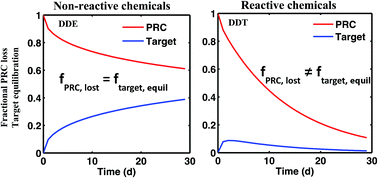当前位置:
X-MOL 学术
›
Environ. Sci.: Processes Impacts
›
论文详情
Our official English website, www.x-mol.net, welcomes your
feedback! (Note: you will need to create a separate account there.)
Passive sampling of DDT, DDE and DDD in sediments: accounting for degradation processes with reaction–diffusion modeling†
Environmental Science: Processes & Impacts ( IF 4.3 ) Pub Date : 2017-12-11 00:00:00 , DOI: 10.1039/c7em00501f A. Patricia Tcaciuc 1, 2, 3, 4, 5 , Raffaella Borrelli 6, 7, 8, 9 , Luciano M. Zaninetta 9, 10, 11 , Philip M. Gschwend 1, 2, 3, 4, 5
Environmental Science: Processes & Impacts ( IF 4.3 ) Pub Date : 2017-12-11 00:00:00 , DOI: 10.1039/c7em00501f A. Patricia Tcaciuc 1, 2, 3, 4, 5 , Raffaella Borrelli 6, 7, 8, 9 , Luciano M. Zaninetta 9, 10, 11 , Philip M. Gschwend 1, 2, 3, 4, 5
Affiliation

|
Passive sampling is becoming a widely used tool for assessing freely dissolved concentrations of hydrophobic organic contaminants in environmental media. For certain media and target analytes, the time to reach equilibrium exceeds the deployment time, and in such cases, the loss of performance reference compounds (PRCs), loaded in the sampler before deployment, is one of the common ways used to assess the fractional equilibration of target analytes. The key assumption behind the use of PRCs is that their release is solely diffusion driven. But in this work, we show that PRC transformations in the sediment can have a measurable impact on the PRC releases and even allow estimation of that compound's transformation rate in the environment of interest. We found that in both field and lab incubations, the loss of the 13C 2,4′-DDT PRC from a polyethylene (PE) passive sampler deployed at the sediment–water interface was accelerated compared to the loss of other PRCs (13C-labeled PCBs, 13C-labeled DDE and DDD). The DDT PRC loss was also accompanied by accumulation in the PE of its degradation product, 13C 2,4′-DDD. Using a 1D reaction–diffusion model, we deduced the in situ degradation rates of DDT from the measured PRC loss. The in situ degradation rates increased with depth into the sediment bed (0.14 d−1 at 0–10 cm and 1.4 d−1 at 30–40 cm) and although they could not be independently validated, these rates compared favorably with literature values. This work shows that passive sampling users should be cautious when choosing PRCs, as degradation processes can affect some PRC's releases from the passive sampler. More importantly, this work opens up the opportunity for novel applications of passive samplers, particularly with regard to investigating in situ degradation rates, pathways, and products for both legacy and emerging contaminants. However, further work is needed to confirm that the rates deduced from model fitting of PRC loss are a true reflection of DDT transformation rates in sediments.
中文翻译:

沉积物中DDT,DDE和DDD的被动采样:通过反应扩散模型说明降解过程†
被动采样正成为评估环境介质中疏水性有机污染物自由溶解浓度的一种广泛使用的工具。对于某些介质和目标分析物,达到平衡所需的时间超过了展开时间,在这种情况下,在展开之前加载到进样器中的性能参考化合物(PRC)的损失是评估分数的常用方法之一。目标分析物的平衡。使用PRC背后的主要假设是,它们的释放完全是由扩散驱动的。但是,在这项工作中,我们表明沉积物中的PRC转化可对PRC的释放产生可测量的影响,甚至可以估算感兴趣环境中该化合物的转化率。我们发现,在现场和实验室孵化中,这13种与其他PRC(13 C标记的PCB,13 C标记的DDE和DDD)的损失相比,来自沉积物-水界面的聚乙烯(PE)无源采样器的C 2,4'-DDT PRC加快了。DDT PRC的损失还伴随着其降解产物13 C 2,4'-DDD在PE中的积累。使用一维反应扩散模型,我们从测得的PRC损失中推论出DDT的原位降解率。在原位与深度降解速率提高到沉积物床(0.14 d -1在0-10厘米和1.4 d -1在30–40 cm处),尽管无法独立验证,但这些比率与文献数据相比还是令人满意的。这项工作表明,被动采样用户在选择PRC时应谨慎,因为降级过程会影响被动采样器中某些PRC的释放。更重要的是,这项工作为被动采样器的新应用打开了机会,尤其是在调查原位降解速率,途径和遗留污染物和新出现污染物的产品方面。但是,需要进一步的工作来确认从PRC损失模型拟合得出的速率是沉积物中DDT转化速率的真实反映。
更新日期:2017-12-11
中文翻译:

沉积物中DDT,DDE和DDD的被动采样:通过反应扩散模型说明降解过程†
被动采样正成为评估环境介质中疏水性有机污染物自由溶解浓度的一种广泛使用的工具。对于某些介质和目标分析物,达到平衡所需的时间超过了展开时间,在这种情况下,在展开之前加载到进样器中的性能参考化合物(PRC)的损失是评估分数的常用方法之一。目标分析物的平衡。使用PRC背后的主要假设是,它们的释放完全是由扩散驱动的。但是,在这项工作中,我们表明沉积物中的PRC转化可对PRC的释放产生可测量的影响,甚至可以估算感兴趣环境中该化合物的转化率。我们发现,在现场和实验室孵化中,这13种与其他PRC(13 C标记的PCB,13 C标记的DDE和DDD)的损失相比,来自沉积物-水界面的聚乙烯(PE)无源采样器的C 2,4'-DDT PRC加快了。DDT PRC的损失还伴随着其降解产物13 C 2,4'-DDD在PE中的积累。使用一维反应扩散模型,我们从测得的PRC损失中推论出DDT的原位降解率。在原位与深度降解速率提高到沉积物床(0.14 d -1在0-10厘米和1.4 d -1在30–40 cm处),尽管无法独立验证,但这些比率与文献数据相比还是令人满意的。这项工作表明,被动采样用户在选择PRC时应谨慎,因为降级过程会影响被动采样器中某些PRC的释放。更重要的是,这项工作为被动采样器的新应用打开了机会,尤其是在调查原位降解速率,途径和遗留污染物和新出现污染物的产品方面。但是,需要进一步的工作来确认从PRC损失模型拟合得出的速率是沉积物中DDT转化速率的真实反映。











































 京公网安备 11010802027423号
京公网安备 11010802027423号